Related Research Articles

Haemodoraceae is a family of perennial herbaceous angiosperms containing 15 genera and 102 known species, sometimes known as the "bloodroots", found throughout the Southern Hemisphere, from Australia and New Guinea to South Africa, as well as the Americas.

Anigozanthos is a genus of plant found naturally in the Southwestern Australia biogeographic region, belonging to the bloodwort family Haemodoraceae. The 11 species and their subspecies are commonly known as kangaroo paw or catspaw, depending on their size, and the shape and colour of their flowers. A further species, previously identified as Anigozanthos fuliginosus, was separated to a monotypic genus as Macropidia fuliginosa. All 11 species of Anigozanthos are endemic to the south west of Western Australia, Noongar Boodjar.

Banksia cuneata, commonly known as matchstick banksia or Quairading banksia, is an endangered species of flowering plant in the family Proteaceae. Endemic to southwest Western Australia, it belongs to Banksia subg. Isostylis, a sub-genus of three closely related Banksia species with inflorescences or flower clusters that are dome-shaped heads rather than characteristic Banksia flower spikes. A shrub or small tree up to 5 m (16 ft) high, it has prickly foliage and pink and cream flowers. The common name Matchstick Banksia arises from the blooms in late bud, the individual buds of which resemble matchsticks. The species is pollinated by honeyeaters (Meliphagidae).

Alexander Segger George is an Australian botanist. He is an authority on the plant genera Banksia and Dryandra. The "bizarre" Restionaceae genus Alexgeorgea was named in his honour in 1976.

Banksia grandis, commonly known as bull banksia or giant banksia, is a species of common and distinctive tree in the south-west of Western Australia. The Noongar peoples know the tree as beera, biara, boongura, gwangia, pira or peera. It has a fire-resistant main stem with thick bark, pinnatisect leaves with triangular side-lobes, pale yellow flowers and elliptical follicles in a large cone.

Banksia goodii, commonly known as Good's banksia, is a species of prostrate shrub that is endemic to a small area in the south-west of Western Australia. It has densely hairy stems, wavy, oblong to egg-shaped leaves with irregularly serrated margins, rusty-brown flowers and hairy fruit. It grows in low forest and woodland near Albany, Western Australia and is listed as "endangered".
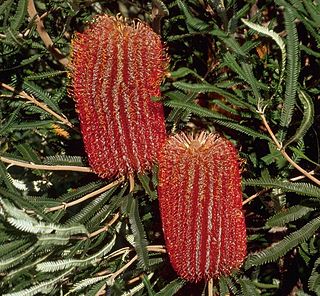
Banksia brownii, commonly known as feather-leaved banksia or Brown's banksia, is a species of shrub that grows in southwest Western Australia. A plant with fine feathery leaves and large red-brown flower spikes, it usually grows as an upright bush around two metres (6.6 ft) high, but can also occur as a small tree or a low spreading shrub. First collected in 1829 and published the following year, it is placed in Banksiasubgenus Banksia, section Oncostylis, series Spicigerae. There are two genetically distinct forms.
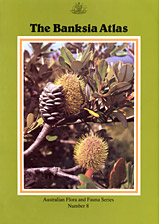
The Banksia Atlas is an atlas that documents the ranges, habitats and growth forms of various species and other subgeneric taxa of Banksia, an iconic Australian wildflower genus. First published in 1988, it was the result of a three-year nationwide program involving over 400 amateur and professional volunteers.

Banksia baxteri, commonly known as Baxter's banksia or bird's nest banksia, is a species of shrub that is endemic to Western Australia. It has greyish brown bark, hairy stems, deeply serrated leaves with triangular lobes and lemon-yellow flowers in an oval flower spike that grows on the end of branches.

Banksia candolleana, commonly known as the propeller banksia, is a species of shrub that is endemic to Western Australia. It has shiny green, deeply serrated leaves with triangular lobes and spikes of golden yellow flowers on short side branches.
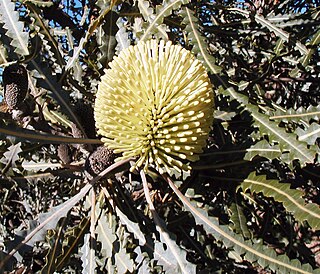
Banksia elegans, commonly known as the elegant banksia, is a species of woody shrub that is endemic to a relatively small area of Western Australia. Reaching 4 m (13 ft) high, it is a suckering shrub that rarely reproduces by seed. The round to oval yellow flower spikes appear in spring and summer. Swiss botanist Carl Meissner described Banksia elegans in 1856. It is most closely related to the three species in the subgenus Isostylis.

Banksia lemanniana, the yellow lantern banksia or Lemann's banksia, is a species of flowering plant in the family Proteaceae, native to Western Australia. It generally grows as an open woody shrub or small tree to 5 m (16 ft) high, with stiff serrated leaves and unusual hanging inflorescences. Flowering occurs over summer, the greenish buds developing into oval flower spikes before turning grey and developing the characteristic large woody follicles. It occurs within and just east of the Fitzgerald River National Park on the southern coast of the state. B. lemanniana is killed by bushfire and regenerates from seed.

Banksia littoralis, commonly known as the swamp banksia, swamp oak, river banksia or seaside banksia and the western swamp banksia, is a species of tree that is endemic to the south-west of Western Australia. The Noongar peoples know the plant as pungura, boongura or gwangia. It has rough, crumbly bark, linear, more or less serrated leaves arranged in whorls, yellow flowers and up to two hundred follicles in each head.
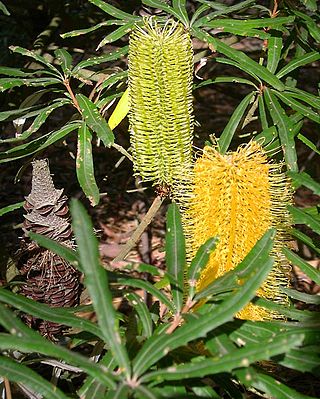
Banksia seminuda, commonly known as the river banksia, is a tree in the family Proteaceae. It is found in southwest Western Australia from Dwellingup (32°42′ S) to the Broke Inlet east of Denmark (34°57′ S). It is often mistaken for, and was originally considered a subspecies of, the Banksia littoralis. Stephen Hopper described the subspecies remanens as a short-leaved shrubby form found in the coastal sands below granite outcrops in the Walpole-Nornalup National Park. However, George does not feel this form warrants taxonomic recognition as it lies within the normal variability of the species and there was no clear distinction between it and the other populations of B. seminuda.
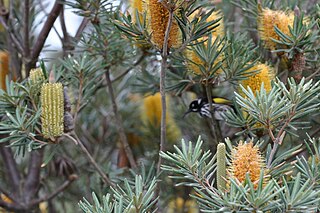
Banksia verticillata, commonly known as granite banksia or Albany banksia, is a species of shrub or (rarely) tree of the genus Banksia in the family Proteaceae. It is native to the southwest of Western Australia and can reach up to 3 m (10 ft) in height. It can grow taller to 5 m (16 ft) in sheltered areas, and much smaller in more exposed areas. This species has elliptic green leaves and large, bright golden yellow inflorescences or flower spikes, appearing in summer and autumn. The New Holland honeyeater is the most prominent pollinator, although several other species of honeyeater, as well as bees, visit the flower spikes.

Anigozanthos manglesii, commonly known as the red-and-green kangaroo paw, Mangles' kangaroo paw, kurulbrang (Noongar), is a plant species endemic to Western Australia, and the floral emblem of that state.

Macropidia fuliginosa, the sole species of genus Macropidia, is a perennial rhizomatous flowering plant. A relation of the kangaroo paws, Anigozanthus, which are also endemic to Southwest Australia, it is referred to as the black kangaroo paw. Bearing unusual black and green flowers, it occurs on a coastal plain from Perth to Geraldton.

Anigozanthos humilis is a species of Anigozanthos in the family Haemodoraceae. This flowering perennial plant is endemic to Southwest Australia and widespread in its open forests. Common names include catspaw and common catspaw.
Philippa Mary Nikulinsky is an artist and botanical illustrator based in Western Australia.
Margaret Pieroni is a Western Australian botanical artist, photographer and botanist who has authored, co-authored or illustrated many books on Australian botany.
References
- ↑ "Birthdays". The Guardian . 18 June 2014. p. 41.
- ↑ "Director (CEO & Chief Scientist) – Professor Stephen D Hopper AC FLS FTSE". History & Heritage. Royal Botanic Gardens, Kew. Archived from the original on 9 March 2014. Retrieved 8 March 2014.
- ↑ Brummitt, R K; Powell, C E (1992). Authors of Plant Names. Royal Botanic Gardens, Kew. ISBN 1-84246-085-4.
- ↑ "Stephen Donald Hopper". Department of the Prime Minister and Cabinet . Retrieved 11 June 2012.
- ↑ "Companion (AC) in the General Division of the Order of Australia – The Queen's Birthday 2012 Honours Lists" (PDF). Official Secretary to the Governor-General of Australia. 11 June 2012. p. 5. Archived from the original (PDF) on 16 June 2012.
- ↑ "'Heaven on Earth' in a botanist's garden". Australian Broadcasting Corporation . 15 January 2016.
- ↑ Hopper, Stephen D (1996), Gondwanan heritage : past, present, and future of the Western Australian biota, Surrey Beatty & Sons in association with Australian Systematic Botany Society and Kings Park and Botanic Garden, Western Australia, ISBN 978-0-949324-66-5
- ↑ Sampson, Jane; Hopper, Stephen; Rainbird, John; Western Australian Wildlife Research Centre (1989), Survey of endangered poison plants of Western Australia : field guide, Western Australian Department of Conservation and Land Management in association with the World Wildlife Fund Australia, retrieved 17 January 2016
- ↑ Taylor, Anne; Hopper, Stephen D; Western Australia. Department of Conservation and Land Management; Australia. Bureau of Flora and Fauna (1991), The banksia atlas (Repr. with amendments ed.), Australian Govt. Pub. Service, ISBN 978-0-644-07124-6
- ↑ Hopper, Stephen D; Wells, Babs; Wells, Bert; Western Australia. Department of Conservation and Land Management (1993), Kangaroo paws and catspaws : a natural history and field guide, Dept. of Conservation and Land Management, ISBN 978-0-7309-5913-7
- ↑ Nikulinsky, Philippa; Hopper, Stephen D; Nikulinsky, Philippa (2005), Soul of the Desert, Fremantle Arts Centre Press, ISBN 978-1-921064-06-7
- ↑ Nikulinsky, Philippa; Hopper, Stephen D (2008), Life on the rocks : the art of survival (Reissued casebound ed.), Fremantle Press, ISBN 978-1-921361-28-9
- ↑ International Plant Names Index. Hopper.